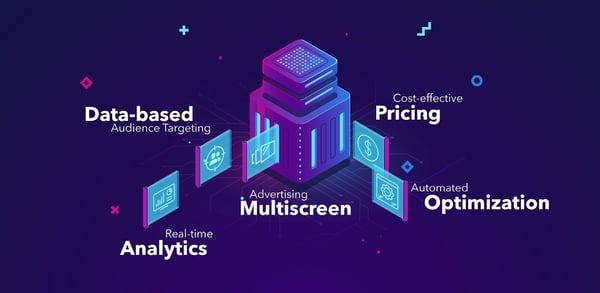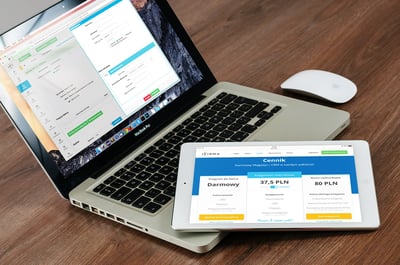

Most successful companies reach out to their audience through targeted online advertising.
Even with targeted advertising, finding the right audience, launching a successful online ad campaign, and adjusting it can be a chore.
With a demand-side platform (DSP), companies and brands can easily boost their marketing efforts and increase ad performance. In this article, we’ll discover how businesses can benefit from using a DSP in their digital marketing strategy. But first, let’s get into what programmatic advertising is and how it works.
Programmatic advertising is an online buying and selling of ad inventory on the automated real-time basis. The automated mode is ensured by sophisticated algorithms that advertising technology companies develop and provide. With programmatic advertising, it’s possible to run most of the available types of ads: display (banner), video, audio, mobile, native, and digital out-of-home (DOOH).
One of the most popular programmatic advertising models is the real-time bidding (RTB) auction. RTB allows to execute auctions on the selling of ad spaces on the Internet in real-time mode.The advertisers here decide how much they are ready to pay for the impression to the exact user (target audience), and the publisher provides a relevant audience and ad inventory (space on the page).
The RTB advertising model includes the following:
The RTB allows advertisers to show their ad on different screens. Today the ability to run in-app campaigns on mobile devices is vital for both advertisers and publishers. Mobile advertising via in-app campaigns provides high click-through rates. In the first quarter of 2019, this digital channel brought $19.5 billion app revenue to publishers.
The entire process of choosing the right ad to show to the user takes just 100 milliseconds on average. When this happens, the SSP instantly receives information on the readiness to display an ad along with the data about the user that nests in the browser’s cookies .
In-app ads are shown to a user in accordance with preset configurations. Through the code of the mobile app, developers define the ad type, the right time and spot for the ad to be displayed. Just like the browser’s cookies, mobile app uses a webview technology to store cookies.
The system is sending the URL of the page where the ad can be placed, the size of the available ad spot, and the anonymous user data. Anonymous user data includes such info as a history of user’s search requests, demographic value, geographical location, and retargeting data. When the SSP provides such a portrait of the user, the DSP can understand whether the person behind the screen is relevant to what advertiser wants to display.
There are a lot of advertisers who want to buy the same inventory. In RTB advertising, the winner of the impression is always defined by the highest bid. To sum it up, here is the scheme of how the programmatic advertising looks like:

When your brand decides to go digital, a DSP is the right place to make the first step. This platform is the technology that allows advertisers (brands and ad agencies) to perform programmatic advertising and buy ad impressions via RTB auctions. The DSP allows advertisers to buy the audience that is likely to be interested in what the brand is offering.
Eventually, it’s not about obtaining an ad space on a website, but getting the relevant traffic and reaching people who will see the message. This is a fine online brand-customer communication channel.
The following are features demand-side platforms offer users.
To find the right audience, the DSPs analyze the data collected from the users’ web journeys and events. The data is shaped into a DMP that contains all the information necessary for DSP to perform targeted advertising. DSP servers contain information based on cookies, first, second, and third data.
Dealing with the right DSP means achieving your ad KPIs effortlessly. The DSP helps you optimize the performance of ad campaigns automatically suggesting the website where the ad will be placed on. You don't have to spend 24/7 watching the performance. The platform suggests the best ad delivery by itself.
With DSP you can reach the audience via desktop, mobile, smart TV (OTT, CTV), tablets, and even DOOH devices. Such diversity allows you to send your USP (unique selling proposition) to any demographic category: starting from mobile-living millennials and centennials, up to baby boomers who are most likely to absorb information from the TV.
Whether you’re are a cozy coffee shop owner or a local entrepreneur that is eager to promote your value to customers, the DSP advertising is affordable for businesses of any size. Set up your ad campaign in your DSP account and invite people around your venue showing targeted ads in real-time.
One of the very important DSP features is the option of real-time performance analysis. As a brand, you can easily track all the valuable ad performance metrics such as reach, coverage, CTR, cost-effectiveness, etc. A DSP helps you optimize the performance of your ad campaigns automatically suggesting the best ad campaign improvements.

With the latest developments in IoT technologies, advertisers are able to reach potential clients 24/7. Online advertising is a perfect option to build a funnel and generate leads for your business. Here are five benefits of using DSP to promote your businesses.
Once you decide to try programmatic advertising, use a DSP self-serve account to run your ad campaign. If you are lucky enough to make a cooperation with a bona fide DSP, you shouldn’t have any problems with onboarding and starting your advertising campaign instantly. The support team will give a step-by-step instruction on how to do that.
Partnership with a reliable DSP media buying provider is more than just a cost-efficient decision for your brand’s ad campaign. It’s about establishing connections with hundreds of high-quality publishers through a single DSP account. DSPs are the gateways to multiple SSPs, websites, and mobile apps where your ad message can be displayed.
Before the DSP media buying was available, advertisers had to use multiple media buying platforms simultaneously and manually configure them to purchase an impression. Today, one single DSP can provide access to a myriad of websites and mobile apps where brands can place ads. On top of that, the platform offers automated optimization to obtain the desired KPIs with minimum efforts.
With DSP, you are capable of reaching all of the relevant audiences your business needs at the price that is comfortable for your budget. By regulating the frequency of impressions you are able to customize the campaign that works best for you.
A clear and transparent supply chain within the DSP media buying platform used to be unattainable. However, the progressive ad tech market leaders use ads.txt and in-app.ads.txt files to achieve the best transparency and build trust within the industry. Some DSPs let media buyers choose the sources to buy traffic from. In this way, after analyzing the performance results, media buyers can define if there is a sense to keep on working with a specific publisher.
Today, digital marketing provides brands with powerful options to promote their product and services. DSP is a modern spaceport to skyrocket any type of business.
Choose the right demand-side platform software, set up your ad campaign, and get ready to drive leads.
Oleg Sokolan is the Director of Demand Operations at Admixer Technologies. He is an accomplished specialist in AdTech with 7+ years of experience. His main professional focus is making programmatic technologies accessible and result-driving for everyone in the industry.
Programmatic is becoming a dominant form of media buying in digital advertising.
 by Elena Storchak
by Elena Storchak
Think “pizza,” and the mind gravitates to cheese: the flavorful ingredient which sets the...
 by Joseph Harisson
by Joseph Harisson
Ad exchanges are primarily brokers for media trading on the open web.
 by Yaroslav Kholod
by Yaroslav Kholod
Programmatic is becoming a dominant form of media buying in digital advertising.
 by Elena Storchak
by Elena Storchak
Think “pizza,” and the mind gravitates to cheese: the flavorful ingredient which sets the...
 by Joseph Harisson
by Joseph Harisson
Never miss a post.
Subscribe to keep your fingers on the tech pulse.



